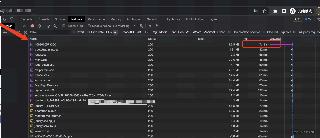python 用遞歸實(shí)現(xiàn)通用爬蟲解析器
我們?cè)趯懪老x的過程中,除了研究反爬之外,幾乎全部的時(shí)間都在寫解析邏輯。那么,生命苦短,為什么我們不寫一個(gè)通用解析器呢?對(duì)啊!為什么不呢?開整!
需求分析爬蟲要解析的網(wǎng)頁(yè)類型無外乎 html、json 以及一些二進(jìn)制文件(video、excel 文件等)。既然要做成通用解析器,我們有兩種實(shí)現(xiàn)方式,一種是將網(wǎng)頁(yè)內(nèi)容轉(zhuǎn)換成統(tǒng)一的形式,然后用對(duì)應(yīng)的解析規(guī)則去解析,比如全部將網(wǎng)頁(yè)內(nèi)容轉(zhuǎn)換成 html 形式,然后用 xpath 去提取。

另外一種是配置文件預(yù)先告知的方式,你配置成什么類型,解析器就通過對(duì)應(yīng)的解析規(guī)則去解析。
統(tǒng)一網(wǎng)頁(yè)形式,需要做大量的網(wǎng)頁(yè)內(nèi)容形式轉(zhuǎn)換,而配置文件預(yù)先告知?jiǎng)t需要在配置時(shí)指定更多解析字段。相比較而言,通過第二種方式,未來改變較多的是配置規(guī)則,不需要?jiǎng)雍诵拇a,引入 bug 的可能性較低。因此這里我們采用第二種方式實(shí)現(xiàn)解析器
進(jìn)一步分析解析器對(duì)于網(wǎng)頁(yè)內(nèi)容的提取,本質(zhì)上和我們?cè)诒镜仉娔X上查找和整理文件,沒有什么差別。比如像下面這樣

解析內(nèi)容就是從中提取我們想要的信息,然后整理成我們希望的格式。比如上面的內(nèi)容,我們提取出來的形式應(yīng)該是這樣
{ 'design': '設(shè)計(jì)圖.psd', 'software': 'sketch.dmg'}
而在實(shí)際的爬蟲開發(fā)過程中,網(wǎng)頁(yè)形式遠(yuǎn)比以上的復(fù)雜。其實(shí)遇到最多的問題是在一組列表中嵌套一個(gè)列表,我們需要把這種形式提取出來。比如像下面這種形式
{ 'a': 'a', 'b': [{'c': 'c1', 'd': 'd1'},{'c': 'c2', 'd': 'd2'}]}
他提取出信息后應(yīng)該是這樣
[ { 'a': 'a', 'c': 'c1', 'd': 'd1' }, { 'a': 'a', 'c': 'c2', 'd': 'd2' }]
如果小伙伴對(duì)于算法熟悉的話,應(yīng)該能察覺出這種遍歷用遞歸來寫是非常方便的。但要注意的是 python 會(huì)限定遞歸的層數(shù),小伙伴可以通過下面這個(gè)方法查看遞歸限定的層數(shù)
import sysprint(sys.getrecursionlimit())>>>1000
我這邊限定的層數(shù)是 1k。對(duì)于解析網(wǎng)頁(yè)來說完全夠用了,如果哪個(gè)人把網(wǎng)頁(yè)解析邏輯嵌套了 1000 層,我建議你直接跟老板提放棄這個(gè)網(wǎng)頁(yè)吧!
再進(jìn)一步分析我們已經(jīng)知道對(duì)于通用解析來說,就是通過配置解析規(guī)則提取頁(yè)面的對(duì)應(yīng)信息。而針對(duì)有列表層級(jí)的網(wǎng)頁(yè)可能還涉及遞歸遍歷問題。那如何去配置這種解析規(guī)則呢?其實(shí)很簡(jiǎn)單,只需要在進(jìn)入每一個(gè)層級(jí)之前先指定該層的數(shù)據(jù)形式,比如下面這個(gè)原數(shù)據(jù)
{ 'a': 'a', 'b': [ {'c': 'c1', 'd': 'd1'}, {'c': 'c2', 'd' : 'd2'} ]}
想提取嵌套信息,我們的解析規(guī)則就應(yīng)該是這樣的
[ { '$name': 'a', '$value_type': 'raw', '$parse_method': 'json', '$parse_rule': 'a', '$each': [] }, { '$name': '__datas__', '$value_type': 'recursion', '$parse_method': 'json', '$parse_rule': 'b', '$each': [{ '$name': 'c', '$value_type': 'raw', '$parse_method': 'json', '$parse_rule': 'c', '$each': []},{ '$name': 'd', '$value_type': 'raw', '$parse_method': 'json', '$parse_rule': 'd', '$each': []} ] }]
其中 $name 字段表示我們最終希望最外層數(shù)據(jù)所擁有的字段名,當(dāng)然如果是需要遞歸到內(nèi)層的字段,則將列表保存為 __datas__ ,然后根據(jù)這個(gè) __datas__ 進(jìn)行內(nèi)層結(jié)構(gòu)的解析。最終我們得到的數(shù)據(jù)結(jié)構(gòu)應(yīng)該是這樣的
[ {'a': 'a', 'c': 'c1', 'd': 'd1'}, {'a': 'a', 'c': 'c2', 'd': 'd2'}]
以上我們只演示了 json 的解析規(guī)則,如果要拿來解析 html 對(duì)象呢?很簡(jiǎn)單,將解析方式改為 xpath 對(duì)象,然后傳入 xpath 解析語法即可。
代碼實(shí)現(xiàn)總共分成兩部分,一部分根據(jù)原最終結(jié)果和規(guī)則進(jìn)行打包,將所有涉及 recursion 邏輯的字段進(jìn)行轉(zhuǎn)換,代碼如下
def _pack_json(result, rules):item = {}for p_rule in rules: if p_rule.get('$value_type') == 'raw':if p_rule.get('$parse_method') == 'json': item[p_rule.get('$name')] = glom(result, p_rule.get('$parse_rule')) elif p_rule.get('$value_type') == 'recursion':if p_rule.get('$parse_method') == 'json': tmp_result = glom(result, p_rule.get('$parse_rule')) total_result = [] for per_r in tmp_result:total_result.append(_pack_json(per_r, p_rule.get('$each'))) item[p_rule.get('$name')] = total_resultreturn item
另外一部分將上一步得到的進(jìn)行解析,將打包得到的結(jié)果進(jìn)行解包,即將所有內(nèi)嵌的數(shù)據(jù)提到最外層,代碼如下
def _unpack_datas(result: dict) -> list:if '__datas__' not in result: return [result]item_results = []all_item = result.pop('__datas__')for per_item in all_item: if '__datas__' in per_item:tmp_datas = per_item.pop('__datas__')for per_tmp_data in tmp_datas: tmp_item = _unpack_datas(per_tmp_data) for per_tmp_item in tmp_item:item_results.append({**per_tmp_item, **per_item}) else:item_results.append({**result, **per_item})return item_results
后再包一層執(zhí)行入口就可以了,完整代碼如下
from loguru import loggerfrom glom import glomdef parse(result, rules): def _pack_json(result, rules):item = {}for p_rule in rules: if p_rule.get('$value_type') == 'raw':if p_rule.get('$parse_method') == 'json': item[p_rule.get('$name')] = glom(result, p_rule.get('$parse_rule')) elif p_rule.get('$value_type') == 'recursion':if p_rule.get('$parse_method') == 'json': tmp_result = glom(result, p_rule.get('$parse_rule')) total_result = [] for per_r in tmp_result:total_result.append(_pack_json(per_r, p_rule.get('$each'))) item[p_rule.get('$name')] = total_resultreturn item def _unpack_datas(result: dict) -> list:if '__datas__' not in result: return [result]item_results = []all_item = result.pop('__datas__')for per_item in all_item: if '__datas__' in per_item:tmp_datas = per_item.pop('__datas__')for per_tmp_data in tmp_datas: tmp_item = _unpack_datas(per_tmp_data) for per_tmp_item in tmp_item:item_results.append({**per_tmp_item, **per_item}) else:item_results.append({**result, **per_item})return item_results pack_result = _pack_json(result, rules) logger.info(pack_result) return _unpack_datas(pack_result)
以上,就是通用解析器的完整案例。案例中僅實(shí)現(xiàn)了對(duì)于 json 的支持,小伙伴可以基于自己的項(xiàng)目,改造成其他的解析形式。通用解析其實(shí)是雞仔為了偷懶寫的,因?yàn)殡u仔發(fā)現(xiàn),在爬蟲開發(fā)中,大部分工作都耗在解析這部分。而有了通用解析的前端頁(yè)面,運(yùn)營(yíng)和數(shù)據(jù)分析師就可以根據(jù)自己的需要配置自己想爬取的站點(diǎn)了。人生苦短,你懂得。我去摸魚了~
實(shí)現(xiàn)方式請(qǐng)移步至 github 查看:https://github.com/hacksman/learn_lab/blob/master/small_bug_lab/general_parser.py
以上就是python 用遞歸實(shí)現(xiàn)通用爬蟲解析器的詳細(xì)內(nèi)容,更多關(guān)于python 遞歸實(shí)現(xiàn)爬蟲解析器的資料請(qǐng)關(guān)注好吧啦網(wǎng)其它相關(guān)文章!
相關(guān)文章:
1. 每日六道java新手入門面試題,通往自由的道路第二天2. 讓chatgpt將html中的圖片轉(zhuǎn)為base64方法示例3. python b站視頻下載的五種版本4. 測(cè)試模式 - XSL教程 - 55. python迭代器自定義類的具體方法6. 手把手教你用python發(fā)送短消息(基于阿里云平臺(tái))7. 教你JS更簡(jiǎn)單的獲取表單中數(shù)據(jù)(formdata)8. python如何寫個(gè)俄羅斯方塊9. Python結(jié)合百度語音識(shí)別實(shí)現(xiàn)實(shí)時(shí)翻譯軟件的實(shí)現(xiàn)10. 《CSS3實(shí)戰(zhàn)》筆記--漸變?cè)O(shè)計(jì)(一)

 網(wǎng)公網(wǎng)安備
網(wǎng)公網(wǎng)安備